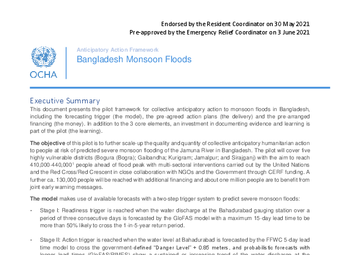Categories
Anticipatory Action Framework: Bangladesh Monsoon Floods
This document presents the pilot framework for collective anticipatory action to monsoon floods in Bangladesh, including the forecasting trigger (the model), the pre-agreed action plans (the delivery) and the pre-arranged financing (the money). In addition to the 3 core elements, an investment in documenting evidence and learning is part of the pilot (the learning).
The objective of this pilot is to further scale-up the quality and quantity of collective anticipatory humanitarian action to people at risk of predicted severe monsoon flooding of the Jamuna River in Bangladesh. The pilot will cover five highly vulnerable districts (Bogura (Bogra); Gaibandha; Kurigram; Jamalpur; and Sirajganj) with the aim to reach 410,000-440,000 people ahead of flood peak with multi-sectoral interventions carried out by the United Nations and the Red Cross/Red Crescent in close collaboration with NGOs and the Government through CERF funding. A further ca. 130,000 people will be reached with additional financing and about one million people are to benefit from joint early warning messages.
The model makes use of available forecasts with a two-step trigger system to predict severe monsoon floods.
The delivery of anticipatory action is time critical. Agencies have agreed to develop a common beneficiary database enabling the joint targeting of households so these may benefit from a comprehensive intervention. In addition, all agencies agree to work jointly on distribution and content of targeted early warning messages.
The framework has been facilitated by OCHA and the RCO and was jointly developed by FAO, UNFPA, UNICEF, WFP, Red Cross/Red Crescent, BDRCS, and the Start Network. Save the Children also contributed.


